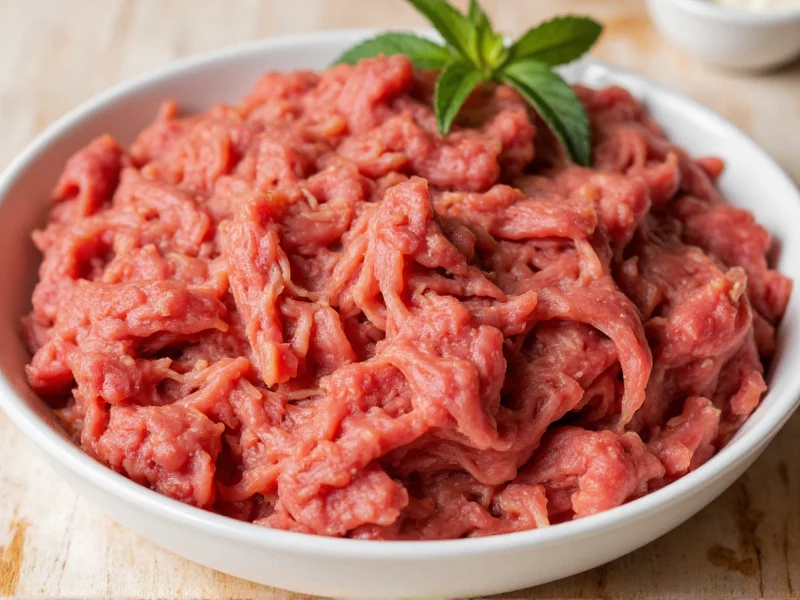Corned beef’s distinctive taste profile results from centuries of culinary evolution, combining preservation science with flavor development. The characteristic flavor emerges from the chemical interaction between the meat proteins and the curing solution during the brining process, which typically lasts 5-10 days. This transformation creates a complex umami-rich experience that’s become beloved in cuisines worldwide.
The Science Behind Corned Beef Flavor Development
The magic of corned beef flavor happens through three interconnected processes: osmosis, protein denaturation, and flavor infusion. As the brisket sits in the brine, salt draws moisture from the meat through osmosis, then gradually re-enters with dissolved flavors. Sodium nitrite prevents bacterial growth while contributing to the pink color and distinctive cured meat aroma through chemical reactions with myoglobin.
During the extended brining period, salt breaks down muscle fibers, allowing the spice components to penetrate deeply. This isn’t merely surface seasoning – the flavors become integral to the meat’s structure. The slow diffusion process creates layered complexity that simple surface seasoning could never achieve.
Essential Components of Authentic Corned Beef Flavor
Understanding what gives corned beef its flavor requires examining its core components:
| Component | Flavor Contribution | Chemical Role |
|---|---|---|
| Salt (Sodium Chloride) | Enhances savory notes, balances sweetness | Preserves meat, extracts proteins |
| Sodium Nitrite | Creates characteristic cured meat aroma | Prevents botulism, fixes pink color |
| Whole Peppercorns | Provides sharp, pungent background notes | Antimicrobial properties |
| Coriander Seeds | Earthy, citrusy undertones | Flavor enhancer |
| Bay Leaves | Subtle herbal complexity | Aromatic infusion |
Traditional Spice Blend Variations
The classic corned beef spice mix varies regionally while maintaining core elements. Irish-American preparations typically feature:
- Whole black peppercorns (sharp, warming)
- Coriander seeds (citrusy, floral)
- Whole cloves (sweet, pungent)
- Bay leaves (earthy, herbal)
- Mustard seeds (tangy, slightly bitter)
- Allspice berries (complex sweet-spicy notes)
New England variations often include additional brown sugar for sweetness, while Jewish deli-style corned beef might feature more garlic and mustard seed. The Irish version traditionally uses less sugar, creating a more savory profile that complements cabbage and potatoes.
How Brining Time Affects Flavor Intensity
The duration of the brining process significantly impacts corned beef’s final flavor profile. Understanding corned beef curing time helps achieve desired results:
- 3-5 days: Lighter flavor penetration, more similar to seasoned boiled beef
- 6-8 days: Balanced flavor development (most common commercial preparation)
- 9-12 days: Intense, deeply penetrated flavor with pronounced cured characteristics
Extended brining creates a more complex flavor profile as the spices fully integrate with the meat proteins. However, exceeding 14 days can result in overly salty meat with diminished texture quality.
Corned Beef Flavor in Culinary Applications
The unique flavor profile of corned beef makes it versatile across various dishes. When exploring how corned beef flavor works in recipes, consider these applications:
- Traditional boiled dinner: The mild sweetness balances cabbage’s bitterness
- Reubens and other sandwiches: The savory notes complement Swiss cheese and tangy dressing
- Hash: Crisping creates caramelized flavor compounds that enhance the cured profile
- Chowders and soups: Adds depth without overwhelming other ingredients
- Breakfast dishes: Pairs well with eggs’ richness and potatoes’ starchiness
Professional chefs often use corned beef fat to flavor beans or vegetables, extracting maximum value from the distinctive taste profile. The rendered fat carries concentrated flavor compounds that can elevate simple dishes.
Common Flavor Misconceptions
Several myths persist about corned beef flavor that deserve clarification. Understanding corned beef taste characteristics helps separate fact from fiction:
- Myth: The pink color comes from artificial dyes
Fact: Sodium nitrite reacts with meat pigments to create stable pink cured color - Myth: All corned beef tastes overly salty
Fact: Properly prepared corned beef has balanced saltiness that enhances rather than dominates - Myth: The flavor comes primarily from cooking method
Fact: Flavor develops during brining; cooking method affects texture more than core flavor - Myth: “Corned” refers to corn syrup or maize
Fact: Term comes from “corns” of salt used in historical preservation
Identifying Quality Corned Beef Flavor
When evaluating what makes good corned beef flavor, look for these characteristics:
- Balanced saltiness that enhances rather than overwhelms
- Noticeable but not overpowering spice notes
- Sweetness that complements rather than competes with savory elements
- Uniform pink color throughout (indicating proper curing)
- Aroma that combines meaty richness with subtle spice notes
Poor quality corned beef often exhibits excessive saltiness, uneven coloration, or artificial-tasting flavors from shortcuts in the curing process. The best examples showcase the natural interplay between the beef’s richness and the carefully balanced spice profile.
Regional Flavor Variations Worth Exploring
Corned beef flavor differs significantly across culinary traditions. Exploring international corned beef taste profiles reveals fascinating adaptations:
- Ireland: More restrained spice profile, less sugar, emphasizing beef’s natural flavor
- United States: Sweeter profile with more pronounced spice notes, especially in New England
- Canada: Often includes additional garlic and mustard seed in the cure
- Caribbean: Incorporates allspice and Scotch bonnet peppers for heat
- South Africa: Uses local spices like dried mango powder for unique tang
These regional variations demonstrate how the fundamental corned beef flavor concept adapts to local palates while maintaining its essential character. The core curing process remains consistent, but spice proportions and additional ingredients create distinctive regional expressions.











 浙公网安备
33010002000092号
浙公网安备
33010002000092号 浙B2-20120091-4
浙B2-20120091-4